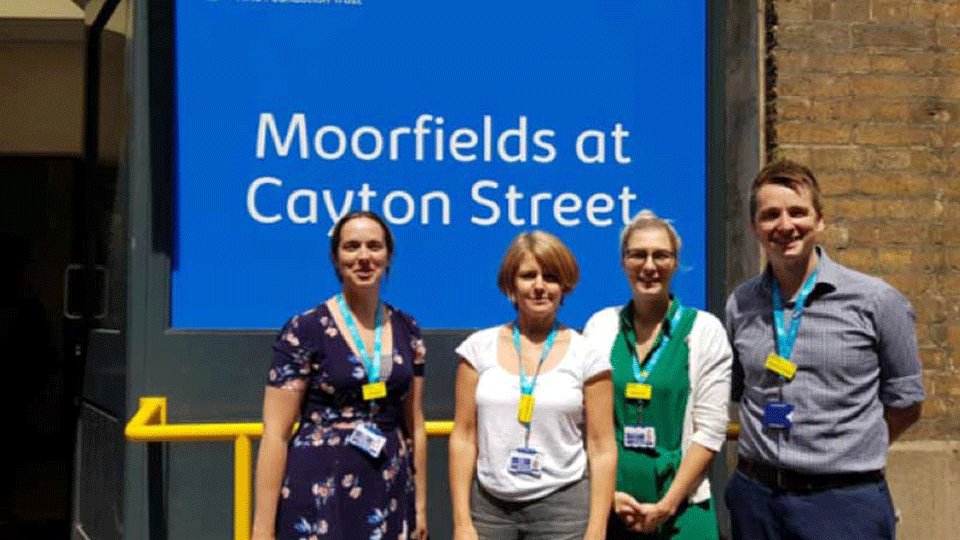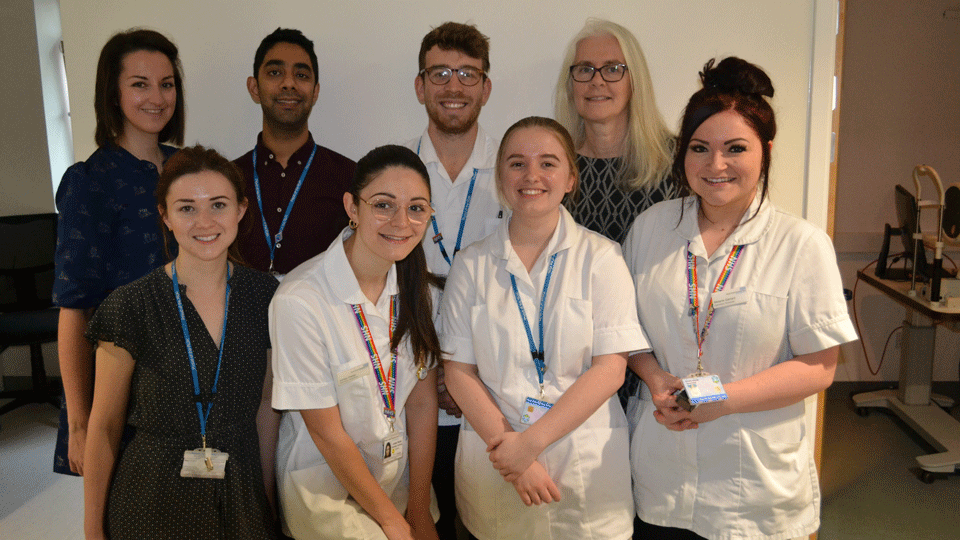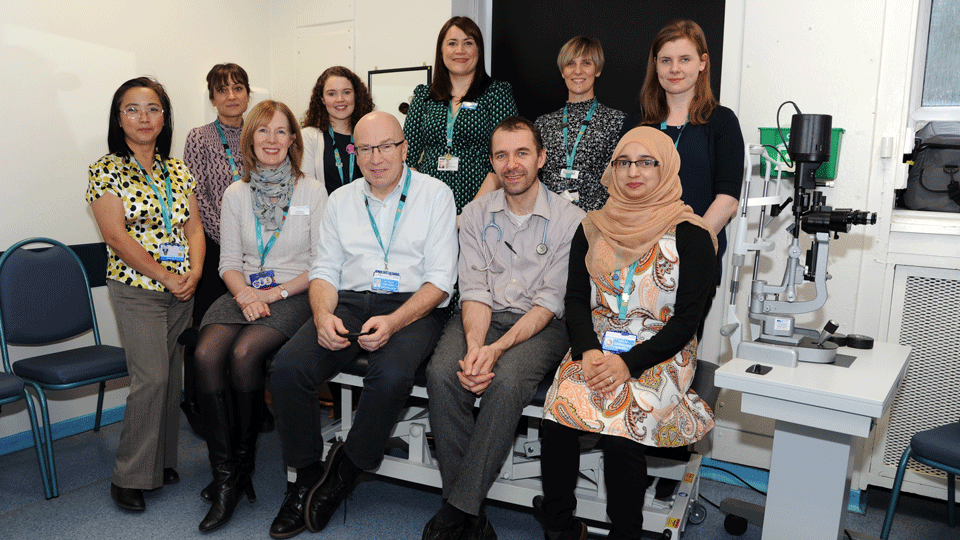- OT
- Professional support
- AOP
- Hospital Optometry Team of the Year
AOP Awards
Hospital Optometry Team of the Year
AOP Awards 2020 Hospital Optometry Team of the Year finalists speak to OT

28 November 2019
OT profiles the Hospital Optometry Team of the Year finalists in the AOP Awards 2020, speaking to them about their achievements, standing out from the crowd and how to work effectively as a team
Optometry-led glaucoma and urgent care service, Moorfields Eye Hospital, London
Optometrist and deputy head of optometry at Moorfields Eye Hospital, Dr Vijay Anand, discusses the benefits that the optometry-led glaucoma and urgent care clinics at the hospital bring the patients and the clinicians

About the team
Hospital: Moorfields Eye Hospital, London
Number of staff: 50+
Clinics available: Too many to list.
Can you share a standout achievement for your hospital team and why?
Our optometrist-led glaucoma clinic was first set up around two years ago. These clinics have a principal optometrist, who is a qualified independent prescriber and has a higher certificate or professional diploma in glaucoma, as well as four specialist optometrists and tech support. The urgent care clinics that run alongside this have four session optometrists and a senior fellow. Both clinics offer an enhanced way of seeing patients in the hospital service.
In order to establish the optometry-led glaucoma clinics, all patients who were attending a consultant-led glaucoma clinic had to be risk-stratified. Those who were deemed to be in the moderately advanced stages of disease and therefore unable to be triaged to the virtual clinic, were directed to the optometrist-led clinic instead. The aim was to try to reduce the burden on consultant-led clinics in the hospital. The urgent care clinic patients are risk-stratified from patients attending A&E.
The best thing that it has achieved for the patients themselves is a reduction in waiting times. When we looked at the journey time for the patients attending the consultant-led glaucoma clinic, they were over the two-hours and those attending A&E were within the four-hour national target mark. However, for those attending the optometrist-led clinic, the waiting time is now around 70 minutes for both optometry-led glaucoma and urgent care
Furthermore, we run the optometry-led glaucoma clinics in the evening and use these as training clinics for other optometrists outside of Moorfields. This allows optometrists across the UK who want to take professional, higher and diploma level qualifications in glaucoma to come in and see patients under supervision. Through this we are helping to train other optometrists around the country.
Clinically, how does your hospital team standout from the crowd?
The commitment that has been put behind the scenes of these clinics, not just by the staff directly working in them, but by the clinical leads. One of the biggest challenges we faced when setting up these clinics was ensuring the consultant ophthalmologists were happy with the clinical protocol set up to ensure patient safety. They spent the best part of eight to nine months going through every patient who was attending a consultant-led clinic, which is probably in the region at 25,000–35,000 patients, to see who could be stratified out into the clinics that the optometrists would be leading in. The drive they had to do this and to ensure that the optometrists were correctly trained was outstanding.
What are the team’s three best attributes?
- The passion that they have for doing a good job with these patients
- The support that they provide each other
- The education and training that they have received through consultants has been second to none.
What is the secret ingredient to working well as a team?
It’s about being able to share knowledge and understanding of what you are trying to achieve with everybody. As long as we continue to do this, we receive buy-in from the whole team, which is important to being able to achieve what we have done.
What is your top tip on building an effective optometry/ophthalmology relationship?
Enabling ophthalmologists to realise that they can’t see all of the patients who need to be seen themselves, considering there are only about 1300 consultants for the whole of the UK-based population who need to come into an eye hospital. Other means of seeing patients are needed which follows the NHS long term plan by identifying other staff groups to safely manage patients clinical care.
Royal United Hospital optometry team, Bath
Optometrist and head of optometry at the Royal United Hospital in Bath, Helen Broadbent, on a team driven by lifelong learning and patient care

About the team
- Hospital: Royal United Hospital, Bath
- Number of staff: Seven optometrists, six technicians, an administrator and an eye clinic liaison officer (ECLO)
- Clinics available: Optometric services including scanning and imaging support to ophthalmology; plus core optometry services including contact lens and peadiatric clinics, low vision and keratoconic monitoring. Extended roles working alongside doctors for medical retina and glaucoma clinics.
Can you share a standout achievement for your hospital team and why?
I nominated the optometry team because of the improvements and developments that we have made within our medical retina clinic over the last 12 months. The effective functioning of the medical retina clinic is something that involves everybody, from our technicians through to our optometrists.
Most recently, we have developed virtual medical retina clinics so our technicians can work more autonomously, while our optometrists have been trained to see new wet age-related macular degeneration referrals coming in. Alongside this, we have moved to become a ‘paper light’ clinic. With all of these changes coming into effect in an already busy clinic, the team has had to work together in order for it to succeed.
There are many patient benefits that come with these changes and the reasons behind many of them were to enable us to keep up with demand and capacity – the pressures that we have on the service are vast and we have to adapt and work a bit smarter.
Patients love the virtual clinics as they are not hanging around in the hospital for as long and are happy about that. New patients coming into the service who are now seen by optometrists benefit from a holistic approach to care; they may receive additional advice about low vision aids, be pointed towards our ECLO service or have their glasses checked, for example.
We have since performed an audit on the clinic, which we presented as a poster at this year’s Hospital Optometrists Annual Conference and won second prize.
Clinically, how does your hospital team standout from the crowd?
The whole team has really embraced the concept of lifelong learning and are all currently studying for higher qualifications. This year alone on the team we have had people qualify as independent prescribers, as well as complete professional certificates in glaucoma and medical retina; everyone is advancing. This continued learning sets the tone for the department and where things are going in optometry. The team is also always prepared to be flexible while putting the patients at the centre of everything they do.
What are the team’s three best attributes?
- They are caring
- They are reliable, always following process and protocol
- They are flexible, happy to adapt and change at a moment’s notice.
What is the secret ingredient to working well as a team?
Communication is key. From my point of view, it’s about making sure that I speak to every single member of the team each day and give them the opportunity to share, whether that is things about work or home. It is also important to be prepared to learn from each other – we have a very open communicative style and there is no such thing as a silly question.
What is your top tip on building an effective optometry/ophthalmology relationship?
It’s about communication and being involved with directorate meetings where appropriate. If we are trying to develop something new in the department, we are always thinking, ‘Can an optometrist do that?’ I understand that there are, of course, things that we can’t do, but there are also lots of things that we can; we have worked in extended roles in this unit since the inception of them and it is something that is embedded in the way we work.
Sheffield Children’s Hospital eye department
Specialist optometrist at the Royal Hallamshire Hospital & Sheffield Children’s Hospital, Joanne Turner, discusses the achievements of the optometry team and what makes them stand out from the crowd

About the team
- Hospital: Sheffield Children’s Hospital
- Number of staff: Five consultant ophthalmologists, four optometrists, 13 orthoptists and four nurses
- Clinics available: Refraction, paediatric contact lens, orthoptic follow up, specialist squint clinic, specialist genetics clinic and orthoptic lead school vision screening. We also work in specialist learning disability/complex neuro disability clinics, which are held off site.
Can you share a standout achievement for your hospital team and why?
We often see very young children who have been recently diagnosed with juvenile idiopathic arthritis (JIA), and have understandably become quite apprehensive about seeing new healthcare professionals. We have built up a repertoire of ways to coax even the most anxious and youngest of children to sit at a slit lamp. As a result, we often perform an adult level slit lamp examination in children under the ages of two. Having a permanent optometrist rather than a registrar who is on rotation means that the children become familiar with their optometrist and we soon gain their trust.
One of our patients who really stands out is an older girl who had attended the clinic for several screening appointments with good vision and no symptoms. Other than the occasional anterior chamber cell, she had never developed into a full episode of uveitis, which can be normal. A specialist optometrist on the team suspected fairly subtle peripheral retinal changes and, with help from the ophthalmic imaging team, we were able to confirm that the patient had pan uveitis and vasculitis. This was quite frightening for our patient, However, the findings have changed her treatment, which has gone on to help change her working diagnosis from that of JIA to Behcets. This patient case has definitely lowered the team’s threshold for requesting ophthalmic imaging. We have no doubt that this experience has made us much more aware of the subtle signs of presentation of potentially sight threatening eye disease.
Clinically, how does your hospital team standout from the crowd?
The uveitis clinic is a tertiary referral clinic, receiving referrals from other hospitals in the area. Patients travel from all over South Yorkshire, Nottinghamshire, Humberside and other neighbouring areas to attend the clinic. Sheffield now holds a frequent inflammatory eye disease study day, which is organised by our consultant team. The team also presents at the well-attended patient day.
We are able to care for every aspect of a patient’s eye care in one visit, including an orthoptic assessment (and treatment when needed), an optometrist slit lamp assessment, a dilated fundus examination and cycloplegic refraction.
The clinic is very flexible and this means that the children presenting with uveitis can be seen straight away by an ophthalmologist. The ophthalmologist is then able to refer into an optometrist for contact lens follow-up or refraction on the day.
Treatment for children found to have uveitis commences immediately in the clinic; whether this be in the form of a topical treatment, or by means of escalating a current treatment to disease modifying biologic drugs, which are perhaps not so easily available in other smaller eye clinics.
The optometrist is trusted implicitly, and all consultants are happy to be approached with questions from the team at any time. From experience we have learned that for optometrists to work well in an extended role, full support is needed from the consultant, and this is definitely the case in our department.
What are the team’s three best attributes?
- We have a broad skill set over a multidisciplinary team and are able to meet patients’ needs in every area in one visit
- Our team is always quick to help each other out and support each other where necessary
- We are flexible and we are happy to see extra patients when needed, going the extra mile to help our colleagues.
What is your top tip on building an effective optometry/ophthalmology relationship?
As optometrists, having an approachable consultant is paramount. Having their trust has allowed us to work in areas that aren’t typical for our profession.
What is the secret ingredient to working well as a team?
Our team is truly multidisciplinary (MDT), consisting of professionals from various areas and backgrounds. We work together for the benefit of the patient, and learn from each other as we go. We bring our sub-specialties to the clinic and we believe that we achieve our shared goal of doing the best for our patients.
We run a weekly MDT meeting, and invite all of the team to attend. This is held in our own time over lunch and enables us to discuss complex patients and their management plan. We also use this time to discuss research projects that the department is involved with.
We are very aware of continuing improvement for the service that we offer; our orthoptist team runs a yearly audit of the optometrist-led uveitis screening clinic. This allows us to ensure we are working to the British Society for Rheumatology paediatric and adolescent guidelines.
As optometrists, having an approachable consultant is paramount. Having their trust has allowed us to work in areas that aren’t typical for our profession


Comments (0)
You must be logged in to join the discussion. Log in